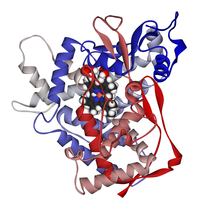
Photo from wikipedia
Inhibition of cytochrome P450 3A4 (CYP3A4), the major drug metabolizing enzyme, by dietary compounds has recently attracted increased attention. Evaluating the potency of the many known inhibitory compounds is a… Click to show full abstract
Inhibition of cytochrome P450 3A4 (CYP3A4), the major drug metabolizing enzyme, by dietary compounds has recently attracted increased attention. Evaluating the potency of the many known inhibitory compounds is a tedious and time consuming task, yet it can be achieved using computing tools. Here, CDOCKER and Glide served to design model inhibitors in order to characterize molecular features of an inhibitor. Assessing nitro-stilbenoids, both approaches suggested nitrostilbene to be a weaker inhibitor of CYP3A4 than resveratrol, and stronger than dimethoxy-nitrostilbene. Nitrostilbene and resveratrol, but not dimethoxy-nitrostilbene, engage electrostatic interactions in the enzyme cavity, and with the haem. In vitro assessment of the inhibitory capacity supported the in silico predictions, suggesting that evaluating the electrostatic interactions of a compound with the prosthetic group allows the prediction of inhibitory potency. Since both programs yielded related results, it is suggested that for CYP3A4, computing tools may allow rapid identification of potent dietary inhibitors.
Journal Title: Food chemistry
Year Published: 2017
Link to full text (if available)
Share on Social Media: Sign Up to like & get
recommendations!